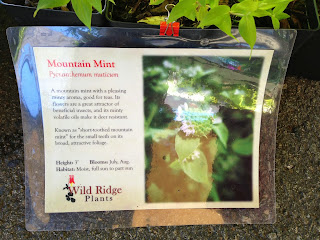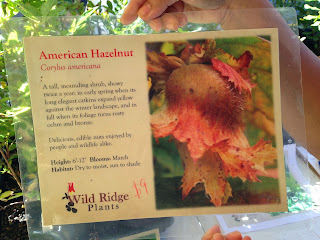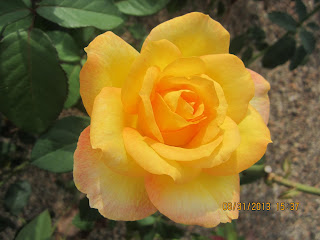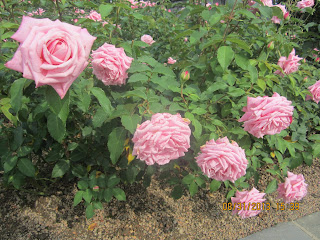People look at the plants and then ask me, "are these sunflowers?" Yes and No. When I tell the people the name of the plant, I get a very understanding nod with the exclamation, "Ah! Artichokes," or "Ah! Artichokes from Jerusalem." NOOOOOOOOO, these are not artichokes and they have nothing to do with Jerusalem.
It's a mystery why they are called Jerusalem Artichokes. One of the theory is that when Pilgrims landed on the US, they depended on this plant, which they learned from the Native Americans, to survive the harsh winter of North-East. Thus, they called this food as the divine food from Jerusalem. Another theory is that Jerusalem is the twisting of the Italian word for sunflower -- Girasol. Whatever the theories might be behind such a name, it is neither an Artichoke nor it came originally from Jerusalem.
It is one of the true native plants of the USA and Canada and can be found from as far as north in Maine to all the way down to Texas. It can be grown under various weather conditions. The beauty and miraculous nature of this plant is mind-blowing. It will start blooming, from late September onward through October, early November, when all other plants are going dormant, dead and are hardly blooming. The plants can easily grow ten feet or more taller as slender plants. It's amazing that they hardly get toppled down by wind or storm. They stand proud, tall and erect. Then they burst into flames -- the whole plants get covered with cheerful yellow flowers. A row of these plants really create spectacular sight as these bright yellow flowers nod and move in the little breeze. Various kind of smaller bees (not the honey-bees or bumble-bees) can be found on these flowers.
Showy, beautiful flowers on the top and heart-healthy, super-food under -- what more can you demand from a plant? The thick potato-like tubers of this plant are what are known as Jerusalem Artichoke. It can be eaten raw, or cooked in any way one likes -- fried, roasted, boiled, made into flour or dehydrated. Potato contains starch and which is not good for diabetic people. That's why often nutritionists recommend JA to replace potato in one's diet. JA contains 80% Inulin, a kind of fructan compound that is very low on glycemic index and is a soluble fiber. Inulin is nowadays considered as a super-food and is a pre-biotic. I do not care about all these super-food gimmicks. I just love eating raw JA as they taste like something between walnut and chestnut.
The tubers should be harvested during the colder months only, that is, in December, January, February or later. When the ground is frozen solid, covered with thick layer and snow and there are hardly any fresh food (unless one has a green-house), one can go out into the field and dig out these foods (Yes, I know what you are thinking -- lots of strength will be required to dig up a frozen solid ground, but just think how wonderfully nature works). Though it is a native sunflower plant, but people here do not grow it as it is considered a weed. And, it does indeed behave like a weed. Put one tuber of JA in the ground and in one single year, it will occupy a significant portion of the garden -- it spreads very fast. So, one has to be very careful while putting it down in a garden. It can also be grown successfully in big pots and will produce a significant amount of tubers (unlike potatoes which will not produce much in a pot unless someone uses a really large pot and/or puts just one potato per pot). One can put the tuber in the ground and then forget about it. It does not require any water, fertilizer or any care. During winter months, harvest whatever one requires and leave the rest in the ground. However, a word of caution -- leaving JA in ground changes it chemical composition -- much of inulin gets converted into fructose. How much of the super-food inulin left in the JA depends upon local weather, how long it was in the ground, harvest time, etc. So, if one is diabetic, one should consult a nutritionist before starting to consume JA.
JA also goes by various other names like sunchokes, sun-root, earth apple, etc. It's biological name is Helianthus Tuberosus, and thus it tells you that it is a sunflower, a perennial sunflower that will come back year after years. the plant with its big leaves, stems and flowers are easy fodder for live-stocks. So, do you have them in your garden, will you be growing them?
Some more random photos from the garden:
It's a mystery why they are called Jerusalem Artichokes. One of the theory is that when Pilgrims landed on the US, they depended on this plant, which they learned from the Native Americans, to survive the harsh winter of North-East. Thus, they called this food as the divine food from Jerusalem. Another theory is that Jerusalem is the twisting of the Italian word for sunflower -- Girasol. Whatever the theories might be behind such a name, it is neither an Artichoke nor it came originally from Jerusalem.
.JPG) |
.JPG) |
 |
It is one of the true native plants of the USA and Canada and can be found from as far as north in Maine to all the way down to Texas. It can be grown under various weather conditions. The beauty and miraculous nature of this plant is mind-blowing. It will start blooming, from late September onward through October, early November, when all other plants are going dormant, dead and are hardly blooming. The plants can easily grow ten feet or more taller as slender plants. It's amazing that they hardly get toppled down by wind or storm. They stand proud, tall and erect. Then they burst into flames -- the whole plants get covered with cheerful yellow flowers. A row of these plants really create spectacular sight as these bright yellow flowers nod and move in the little breeze. Various kind of smaller bees (not the honey-bees or bumble-bees) can be found on these flowers.
Showy, beautiful flowers on the top and heart-healthy, super-food under -- what more can you demand from a plant? The thick potato-like tubers of this plant are what are known as Jerusalem Artichoke. It can be eaten raw, or cooked in any way one likes -- fried, roasted, boiled, made into flour or dehydrated. Potato contains starch and which is not good for diabetic people. That's why often nutritionists recommend JA to replace potato in one's diet. JA contains 80% Inulin, a kind of fructan compound that is very low on glycemic index and is a soluble fiber. Inulin is nowadays considered as a super-food and is a pre-biotic. I do not care about all these super-food gimmicks. I just love eating raw JA as they taste like something between walnut and chestnut.
.JPG) |
.JPG) |
 |
The tubers should be harvested during the colder months only, that is, in December, January, February or later. When the ground is frozen solid, covered with thick layer and snow and there are hardly any fresh food (unless one has a green-house), one can go out into the field and dig out these foods (Yes, I know what you are thinking -- lots of strength will be required to dig up a frozen solid ground, but just think how wonderfully nature works). Though it is a native sunflower plant, but people here do not grow it as it is considered a weed. And, it does indeed behave like a weed. Put one tuber of JA in the ground and in one single year, it will occupy a significant portion of the garden -- it spreads very fast. So, one has to be very careful while putting it down in a garden. It can also be grown successfully in big pots and will produce a significant amount of tubers (unlike potatoes which will not produce much in a pot unless someone uses a really large pot and/or puts just one potato per pot). One can put the tuber in the ground and then forget about it. It does not require any water, fertilizer or any care. During winter months, harvest whatever one requires and leave the rest in the ground. However, a word of caution -- leaving JA in ground changes it chemical composition -- much of inulin gets converted into fructose. How much of the super-food inulin left in the JA depends upon local weather, how long it was in the ground, harvest time, etc. So, if one is diabetic, one should consult a nutritionist before starting to consume JA.
JA also goes by various other names like sunchokes, sun-root, earth apple, etc. It's biological name is Helianthus Tuberosus, and thus it tells you that it is a sunflower, a perennial sunflower that will come back year after years. the plant with its big leaves, stems and flowers are easy fodder for live-stocks. So, do you have them in your garden, will you be growing them?
Some more random photos from the garden:
 |
 |
 |











.JPG)


























































